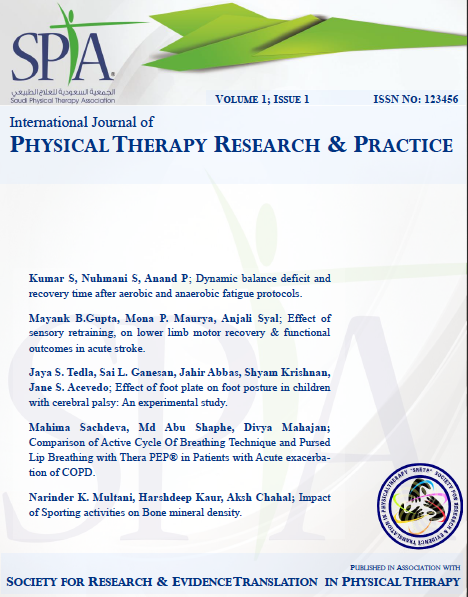Association Between Hip Strength and Dynamic Balance in Stroke Survivors with Coexisting Knee Osteoarthritis
DOI:
https://doi.org/10.62464/ijoprp.v4i5.108Keywords:
Physical Therapy, Rehabilitation, Musculoskelatel, OrthopedicAbstract
Background: Stroke patients often experience impaired balance and mobility, which may be exacerbated by comorbid knee osteoarthritis (OA). Hip muscle weakness is a key contributor to reduced dynamic stability in these populations. Objective: To examine the association between hip muscle strength and dynamic balance in stroke survivors with and without knee OA. Methods: This cross-sectional study included 37 post-stroke participants (20 without OA, 17 with OA). Hip flexion and extension strength were assessed using manual muscle testing (MMT). Balance was evaluated via One-Leg Stance (OLS), Center of Pressure (COP) range and sway, and the Functional Reach Test (FRT). Results: Stroke patients with OA demonstrated significantly lower hip strength and impaired balance performance compared to those without OA. Hip flexor and extensor strength on the affected side showed moderate correlations with OLS (r = 0.52), COP sway (r = 0.49), and FRT (r = 0.45). The OA group had reduced OLS time (p < 0.05) and a smaller COP range. Conclusion: Hip muscle weakness is significantly associated with compromised dynamic balance in stroke patients with knee OA, underscoring the importance of hip-focused rehabilitation strategies in this population.
References
Al-Khlaifat, L., Herrington, L., Tyson, S., Hammond, A., & Jones, R. (2016). The effectiveness of an exercise program on dynamic balance in patients with medial knee osteoarthritis: A pilot study. The Knee, 23(5), 849–856. https://doi.org/10.1016/j.knee.2016.05.006
Ayotte, N. W., Stetts, D. M., Keenan, G., & Greenway, E. H. (2007). Electromyographical analysis of selected lower extremity muscles during five unilateral weight-bearing exercises. Journal of Orthopaedic & Sports Physical Therapy, 37(2), 48–55.
Bennell, K., Hunt, M. A., Wrigley, T., Hunter, D. J., & Hinman, R. S. (2007). The effects of hip muscle strengthening on knee load, pain, and function in people with knee osteoarthritis: A protocol for a randomized, single-blind controlled trial. BMC Musculoskeletal Disorders, 8, 121. https://doi.org/10.1186/1471-2474-8-121
Choi, S. H., Lee, S. D., & Kim, H. S. (2020). Effects of rehabilitation on reaction time in stroke patients with knee osteoarthritis. Neurorehabilitation and Neural Repair, 34(6), 537–546. https://doi.org/10.1177/1545968320907578
Deasy, M., Leahy, E., & Semciw, A. (2016). Hip strength deficits in people with symptomatic knee osteoarthritis: A systematic review with meta-analysis. Journal of Orthopaedic & Sports Physical Therapy, 46(12), 1051–1067. https://doi.org/10.2519/jospt.2016.6618
Dobson, F., Hinman, R. S., Hall, M., Terwee, C. B., Roos, E. M., & Bennell, K. L. (2012). Measurement properties of performance-based measures to assess physical function in hip and knee osteoarthritis: A systematic review. Osteoarthritis and Cartilage, 20(12), 1548–1562. https://doi.org/10.1016/j.joca.2012.08.015
Fransen, M., McConnell, S., & Bell, M. (2002). Therapeutic exercise for people with osteoarthritis of the hip or knee: A systematic review. The Journal of Rheumatology, 29(8), 1737–1745.
Li, Y., Su, Y., Chen, S., Zhang, Y., Zhang, Z., Liu, C., Lu, M., Liu, F., Li, S., He, Z., Wang, Y., Sheng, L., Wang, W., Zhan, Z., Wang, X., & Zheng, N. (2015). The effects of resistance exercise in patients with knee osteoarthritis: A systematic review and meta-analysis. Clinical Rehabilitation, 30(2), 105–115. https://doi.org/10.1177/0269215515610039
Mat, S., Ng, C. T., & Tan, M. P. (2017). Influence of hip and knee osteoarthritis on dynamic postural control parameters among older fallers. Journal of Rehabilitation Medicine, 49(4), 320–325. https://doi.org/10.2340/16501977-2202
Mehwish, Bushra, Syed, S., & Baig, A. A. M. (2023). Effect of hip joint mobilizations and strength training on pain, physical function and dynamic balance in patients with knee osteoarthritis: A randomized controlled trial. Journal of the Pakistan Medical Association, 73, 751–754. https://doi.org/10.47391/JPMA.6223
Pua, Y.-H., Wrigley, T., Collins, M., Cowan, S., & Bennell, K. (2009). Association of physical performance with muscle strength and hip range of motion in hip osteoarthritis. Arthritis & Rheumatism, 61(4), 442–450. https://doi.org/10.1002/art.24344
Qiu, J., Zhou, T., Jin, H., Pan, Y., Qian, T., Xue, C., Xia, W., Shi, H., & An, B. (2023). Effect of adding hip exercises to general rehabilitation treatment of knee osteoarthritis on patients’ physical functions: A randomized clinical trial. BMC Sports Science, Medicine and Rehabilitation, 15, Article 7. https://doi.org/10.1186/s13102-023-00772-7
Sánchez-Herán, Á., Agudo-Carmona, D., Ferrer-Peña, R., López-de-Uralde-Villanueva, I., Gil Martínez, A., Paris-Alemany, A., & La Touche, R. (2016). Postural stability in osteoarthritis of the knee and hip: Analysis of association with pain catastrophizing and fear-avoidance beliefs. PM&R, 8(6), 511–519. https://doi.org/10.1016/j.pmrj.2015.11.002
Takacs, J., Krowchuk, N., Garland, S. J., Carpenter, M., & Hunt, M. (2017). Dynamic balance training improves physical function in individuals with knee osteoarthritis: A pilot randomized controlled trial. Archives of Physical Medicine and Rehabilitation, 98(8), 1586–1593. https://doi.org/10.1016/j.apmr.2017.01.029
Wellsandt, E., & Golightly, Y. M. (2017). Exercise in the management of knee and hip osteoarthritis. Current Opinion in Rheumatology, 30(1), 1–7. https://doi.org/10.1097/BOR.000000000000047
World Health Organization. (2003). The burden of musculoskeletal conditions at the start of the new millennium: Report of a WHO scientific group (WHO Technical Report Series No. 919). WHO.

Downloads
Published
Issue
Section
License
Copyright (c) 2025 International Journal of Physical Therapy Research & Practice

This work is licensed under a Creative Commons Attribution-NonCommercial-NoDerivatives 4.0 International License.



